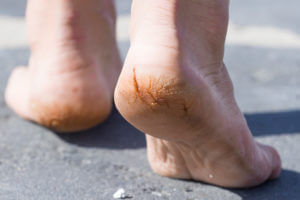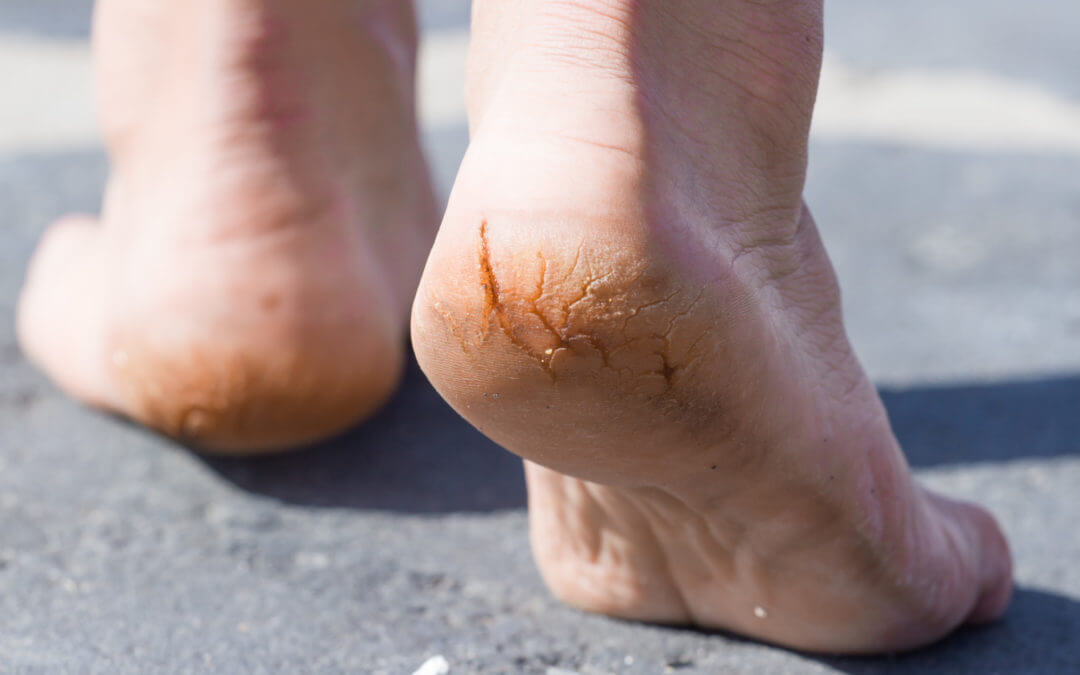Dry Cracked Heels: The Causes of a Common Foot Condition
Summer is winding down and by now you may be noticing that your heels are looking kind of rough. Dry, cracked heels are a frequent woe of summer sandal wearers. Apart from being unsightly, they’re just uncomfortable, especially when you get the deep fissures.
of summer sandal wearers. Apart from being unsightly, they’re just uncomfortable, especially when you get the deep fissures.
But what causes cracked heels? Read on to find out!
Obesity
What does excess weight have to do with cracked heels? Quite a bit, actually.
For one, excess weight makes your feet work harder whenever you’re standing or walking on them. Obesity also causes the fat pad on your heels to expand sideways and the increased pressure makes heels more likely to crack.
On top of that, obese people who are also diabetic may experience less circulation to the feet, meaning they’ll heal at a much slower rate.
Dehydration
Your mom was right, it is important to make sure you’re properly hydrated throughout the day. Here’s the deal, water is incredibly important to your entire body and it is required in order for your body to work properly. When your body becomes dehydrated, your body is going to draw water from your skin in order to keep your organs functioning.
That means you need to drink enough water to keep your organs healthy and your skin supple. Cracked heels are a sign that you’re just not getting enough H2O.
Ill-Fitting Shoes
Wearing shoes that are a little (or a lot) snug or loose can lead to major issues with cracked heels. Constant rubbing against your heels can cause irritation and dryness. Make sure you’re wearing shoes that fit you well, especially if you’re going to be in them for several hours or doing heavy-duty work.
Genetics
Sometimes cracked heels, or lack thereof, are luck of the draw. Some people are predisposed to form thick callouses on their heels and feet and others are not. If you know that others in your family have suffered from cracked heels, then you should take precautionary measures to prevent having to deal with them yourself.
Keep your heels exfoliated and moisturize them at night to keep skin soft and supple.
Standing for Long Hours
Another major contributing factor to cracked heels is having to spend long hours standing on your feet. If you work a retail job, you probably notice that your heels are dry and cracked all year long.
If you must stand for long hours, make sure you wear properly fitted and cushioned shoes, or stand on a cushioned mat to reduce the amount of pressure on your heels.
Struggling with Dry, Cracked Heels?
There are a number of factors that contribute to dry, cracked heels. We know it’s a common phrase, but it’s true in the case of cracked heels that an ounce of prevention is worth a pound of cure. Staying hydrated, properly maintaining your feet, and avoiding long periods on your feet will go a long way to keeping your heels in summer shape.
Need a little extra help getting your feet in shape? You’ve come to the right place. Contact us today to see how we can help!
The information provided in this article is not meant to be medical advice and is for educational purposes only. If you would like to learn more about topics related to podiatry, feel free to contact Family Foot & Ankle Centers by clicking here or calling 972-597-4132 to reach our Waxahachie office, 903-872-9910 to reach our Corsicana office, or 972-875-3668 to reach our Ennis office.



